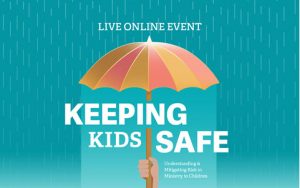“Keeping Kids Safe” – Webinar Recap

This week KidCheck participated in the International Children’s Ministry (INCM) “Keeping Kids Safe” online event. The event offered leaders a better understanding of safety and minimizing security risks in children’s ministry. Training sessions included speakers from American Church Group, Protect My Ministry, Plan to Protect, Shadow Mountain Community Church, KidCheck, and more.
KidCheck discussed with Heidi Hensley, the Children’s Pastor at Shadow Mountain Community Church, the importance of doing a Child Safety Assessment (CSA) and why right now, while the pace of ministry is slower, is a perfect time. We outlined the two critical questions to ask during the CSA: “Is my organization as safe as it can be? What does safety look like in the new normal of COVID-19?”
We also highlighted the benefits of a CSA for both families and organizations. For families, the benefits included opening the lines of communication, confidence building, and encouraging engagement when families return. For organizations, the benefits include an increased opportunity of seeing things that may have been missed, prioritizing child safety, and helping to establish a new rhythm after isolation.
There are four essential elements of a CSA for Phase 1 of a church’s reopening plan during COVID-19. KidCheck shared the details of each component, and Heidi highlighted the actions she’s taking within her community.
- Family Survey – A survey focused on evaluating child safety and learning the pulse of where your families currently are in the process of returning after self-isolation. The survey should be 5-10 minutes long and include a part for children to provide feedback, share their experiences, and observations. Heidi’s organization has been encouraging engagement since isolation began with weekly Zoom meetings, children’s ministry & worship videos, parent emails, and consistent direct communication.
- Communication Strategy – The communication strategy should have already started and continued as families begin to return during Phase 1. The plan should include staff, volunteers, families, and leadership. Set a schedule and stagger outgoing messaging to provide time for replying promptly and evaluating relevant information and feedback.
- A Safeguarding Committee – It’s a committee comprised of 2-5 people tasked with improving child safety by coming alongside the children’s ministry pastor to implement the child protection policy, rollout COVID-19 new process implementation, and work as a liaison with the security team. Heidi utilized a group of parents who saw things they didn’t like and worked with her to implement new processes and procedures.
- Technology – Technology should solve issues, improve efficiency, and make protocols like germ management and social distancing easier. An example is KidCheck Express mobile check-in. It’s the fastest way for families to check-in children using a touchless process. Express Check-In allows families to check-in using their own mobile device and pick up labels that are pre-printed guardian tags onsite once they arrive. With Express, there’s no need to stand in line or use a check-in station, helping with social distancing and germ management. For check-in, Heidi’s church is moving seven of their check-in stations outdoors, allowing only one parent per family in the building to drop off, and utilizing a completely touchless check-in process. Her goals for technology are to help reduce lines, encourage social distancing, improve germ management.
We also discussed best practices for physical distancing, sanitation and hygiene, and procedural modifications. For physical distancing, ideas to maintain 6ft with children’s ministry include offering the more vulnerable children a separate entrance and exit space, and limiting the number of kids per class. For sanitation, Heidi’s process includes placing items in the room that have been touched in a garment bag and storing them in one place after each use so they can be sanitized the following day by a volunteer. Multi-use areas such as classrooms and the nursery are disinfected between each service. Additional procedural modifications Heidi is considering include taking a child’s temp before admitting them to the children’s ministry area, volunteers wearing masks, providing a separate place if a child or volunteer becomes sick, and continuing with an online service for children throughout phase 1 and 2.
Several resources are available to help understand what phase 1 and phase 2 of a reopening plan look like for organizations and how to interpret federal guidelines to individual state requirements.
For more information on using the benefits of secure children’s check-in, join us for a personalized demo or join our growing social community. We’re on Facebook, Twitter, Instagram, and Pinterest.


